Claytonia virginica, Virginia spring beauty, is a native herbaceous perennial plant that is a true spring ephemeral.
Flowers
Inflorescence - flower cluster:
Spring beauty (Claytonia virginica), flowers grow in a small loose cluster along the end of a single central stem with each flower having its own stalk (raceme arrangement). The cluster can have 5 to 20 flowers and as the stem elongates the cluster tends to droop under its own weight. The central stem can be 10 inches long/tall. The flowers mature from the bottom up. Only a few flowers bloom at a time on a single plant. In a large cluster, the lower flowers are frequently starting to fruit while the top flowers are still buds, so the only conspicuous flowers are the few in the middle of the flower stem.
Individual flowers:
Each flower is about a half inch to 3 quarters of inch across with 2 green sepals, 5 petals and 5 stamens and one pistil. The petals are pink to white with distinctive darker pink veins. The stamens have pale to deep pink anthers. The flower petals can vary in width. The pink veins and the stamen filaments reflect UV light and guide pollinators to the nectar at the base of the petals. At night and on cloudy/rainy days, the flowers do not open to conserve pollen and nectar and the flowers tend to droop. When the sun comes out, the flowers open and face the sun and they are ready for business.
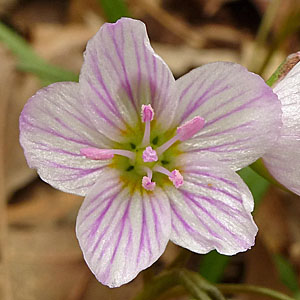

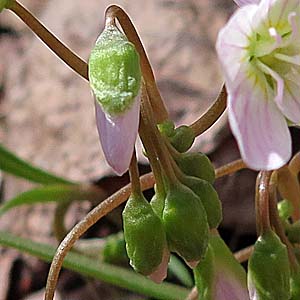
Pollination - Protandry:
The spring beauty plant tries to minimize self pollination. One method many plants use is protandry where the stamens (male structures) of a flower mature before the pistil (female structure). Since the flowers bloom from the bottom up, the lower flowers would be older and in the female phase and the upper flowers would be in the male phase. Usually, on one flower stalk, one or two flowers will be in the male-phase, and two or more flowers will be in the female-phase.
The 2 photos below show flowers in the male phase. The stamens are upright, the anthers are mature and a few are releasing pollen. In the first photo the white stigma of the pistil in the middle is not yet mature and not receptive to pollen. The second photo shows more clearly that the stamens are upright and close to the pistil. The style of the pistil is in front of the 5th anther. The flowers will remain in the male phase for about a day and then the flowers transition to the female phase.


The 2 photos below show flowers in the female phase. The stigma is tri-parted and open and ready for pollen. The stamens are depleted and bent back away from the stigma. The first photo shows the stigma clearly. The second photo is at a greater angle and it is easier to see that the stamens are bent away from the pistil and drying up. The green ovary is clearly seen. The flower will remain in the female phase for one day and up to a week if it doesn't get pollinated. Flies and small native bees are pollinators for spring beauty but the small native bees are the primary pollinators.

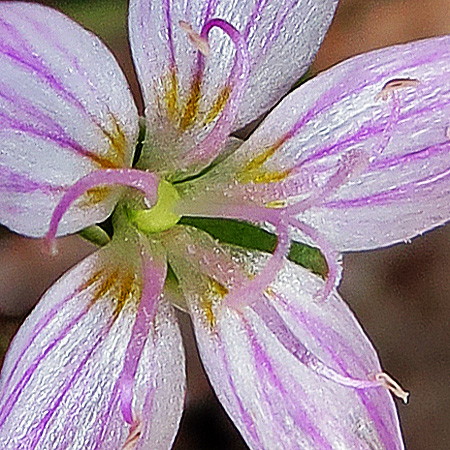
Flower color:
As you may have noticed the petal color varies from almost pure white to pinkish petals with deep pink veins. Does this have any effect on its survival?
A research paper was done by Frank M. Frey in 2004 at Indiana University. It was a 2 year field study with auxilliary lab studies. Four flower color groups were distinguished from mostly white to mostly red.
Color variation was genetic and the color genetics also affected traits other than color.
This report found increased pollination with flower redness. Also the report showed that flower redness was associated with more herbivory (slug damage to leaves) and with less damage by disease (rust infection). With these opposing tendencies, a situation where poplulations of all the variants become viable.
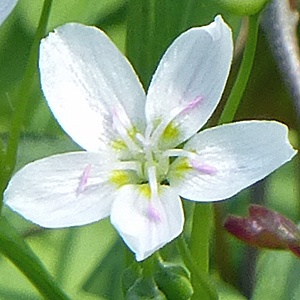
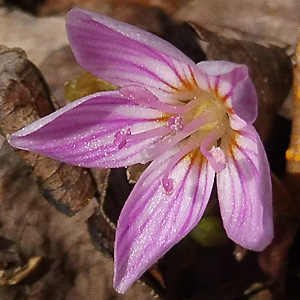
Fruit
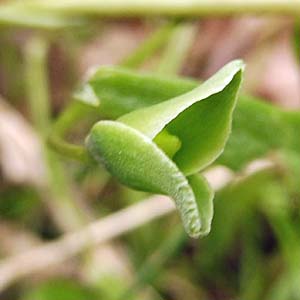
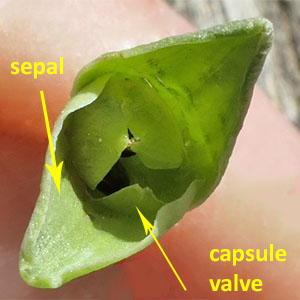
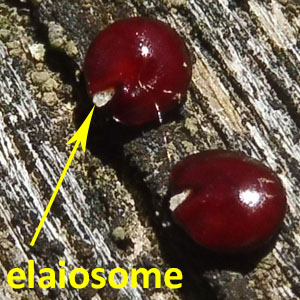
Each fertile flower produces a smooth ovoid capsule. The capsule is enclosed by the two persistent sepals. It takes about 10 days to form the fruit.
The capsule has 3 valves which open for release of the seeds.The capsule contains 3 to 6 shiny black seeds. Each seed has a small fleshy attachment, known as an elaiosome, that are rich in fats. This facilitates dispersal and burial of the seed by ants which is known as myrmecochory. In the photo the elaiosomes are white
Leaves and Plant
Leaves
Spring beauty has both basal leaves and sessile cauline (on the stem) leaves. Both kinds of leaves are long and narrow, grass like, not hairy, have smooth edges and are slightly fleshy with a prominent midrib. The basal leaves can get to be 12 inches long. The cauline leaves are simple and opposite and occur about midway up the stem. The cauline leaves are 2 to 5 inches long.
When you have a cluster of plants, all the leaves, central stems and flowers are all entangled.
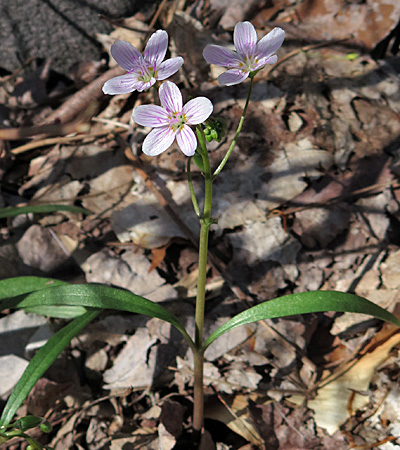
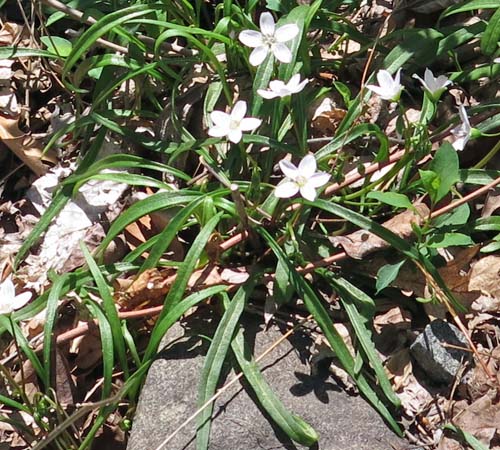
Storage
Since spring beauty is a perennial it needs to store energy for the next season. Food storage is in a roundish corm (underground swollen stem) and the corm contains carbohydrates, nutrients and other essential compounds.
Life cycle - spring ephemeral
Below Ground Growth Phase (hypogeous):
After the above ground strucures disappear, the plant goes into dormancy. However, there are important activities that take place throughout the summer, fall and winter. Dormancy is not very deep during summer when differentiation occurs in the corm buds. Low soil temperatures in the fall and winter reduce dormancy and initiate growth and allow the root system and shoots to slowly develop. To do this, the plant uses large amounts of its reserves which were accumulated in the corm from previous growing seasons.
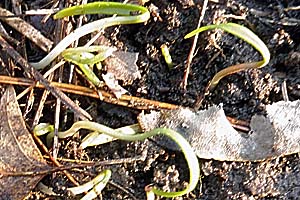 During fall/winter growth, multiple shoots can develop from a single large corm. New basal leaves and shoots form from the corm and radiate out horizontally underground and under the leaf litter. When the leaves are exposed to sunlight, they become green.
These new leaves and shoots can extend several inches away from the corm. Only mature plants produce flowers. If there's only one leaf, there won't be any flowers. Only plants with 2 leaves are mature enough to produce flowers.
During fall/winter growth, multiple shoots can develop from a single large corm. New basal leaves and shoots form from the corm and radiate out horizontally underground and under the leaf litter. When the leaves are exposed to sunlight, they become green.
These new leaves and shoots can extend several inches away from the corm. Only mature plants produce flowers. If there's only one leaf, there won't be any flowers. Only plants with 2 leaves are mature enough to produce flowers.
In the very early spring, the corm continues to supply the necessary nutrients etc. to the emerging leaves and shoots.
The image shows leaves just emerging from the ground with the leaf litter removed. Leaves are curled and just turning pale green (March 10).
Above Ground Growth Phase (epigeous):
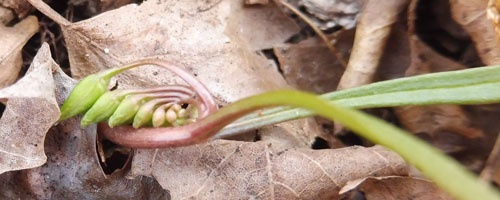 Early plant with two leaves and flower buds from beneath leaf litter
Early plant with two leaves and flower buds from beneath leaf litter
Spring beauty as a spring ephemeral is adapted to take advantage of the high level of light, water and nutrients that is available in early spring. Soil temperature for root and shoot growth and air temperature for vegetative above ground growth must be synchronized with available sunlight for photosynthesis and insect pollination. The above ground activities, leaf production, flower production, fruit production, and energy storage for the next year are completed in about 2 months.
To help the plant get started, even in early spring, large amounts of both carbohydrates and nutrients are transported from the corm to the developing shoots. Once the photosynthetic rates are high the plant can rapidly accumulate carbohydrates even at low temperatures. Since the nutrient absorption rate is slow throughout the spring, the plant is restricted to rich forest soils. However, the plant efficiently transports the nutrients to the corm during leaf senescence (process of the leaves transporting essential compounds to the corm and dying).
Flowers of spring beauty open when the air temperature exceeds 52°F and then their pollinators can fly. When canopy growth restricts the light, and competition for water, and nutrients increases, then spring beauty starts leaf senescence. The plant produces new buds in the corm before it senesces and then enters dormancy.
Habitat
Spring beauty is generally found in moist woods in rich moist soil in the woods and along woodland edges.
Dry spring weather and hot summers can wipe them out.
Spring Beauty is an indicator that spring has arrived and the woods are filled with diverse wildflowers. Time to take in a hike! An absence of spring beauty from woodlands indicates that the habitat has been degraded.
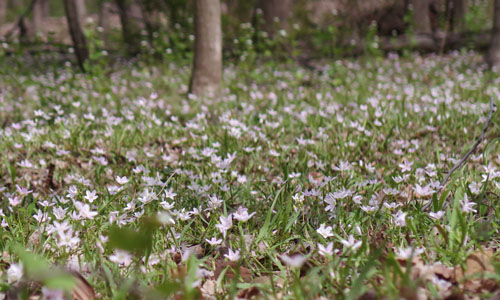
Text by Millie Ling and all photos by Hubert & Millie Ling: flowers - late March to May, various parks/preserves and cultivation, NJ
Cultivation
The cultivation material below is courtesy of
Jersey Friendly Yards searchable plant database: Claytonia virginica - Spring Beauty
Deer Resistance: High
Salt Tolerance: unknown
Hardiness Zone: 6a, 6b, 7a, 7b
Physiographic Region: All Regions in NJ
Soil Type: Loam, Organic, Clay
Soil Moisture: Medium-drained
Soil pH: Acidic, Slightly Acidic, Neutral
Optimal Light: Partial Shade
Light Range: Full Sun, Partial Shade
Drought Tolerance: Low
Growth Rate: Slow
Additional information / References
Additional information / references:
The USDA website : Virginia Spring Beauty distribution in the US and other information, https://plants.usda.gov/core/profile?symbol=clvi3
Arkansas Native Plant Society:Know Your Natives – Spring-Beauty: Excellent article which also includes the corm and roots https://anps.org/2021/01/24/know-your-natives-spring-beauty/
Research paper on flower color: spring beauty flower color
Information spring ephemeral life cycle:
Only abstract which is informative is free.
How phenology influences physiology in deciduous forest spring ephemerals
This article includes references.
Spring Ephemerals in Ontario
Good gardening information: Jersey Friendly Yards https://www.jerseyyards.org/plant/claytonia-virginica/